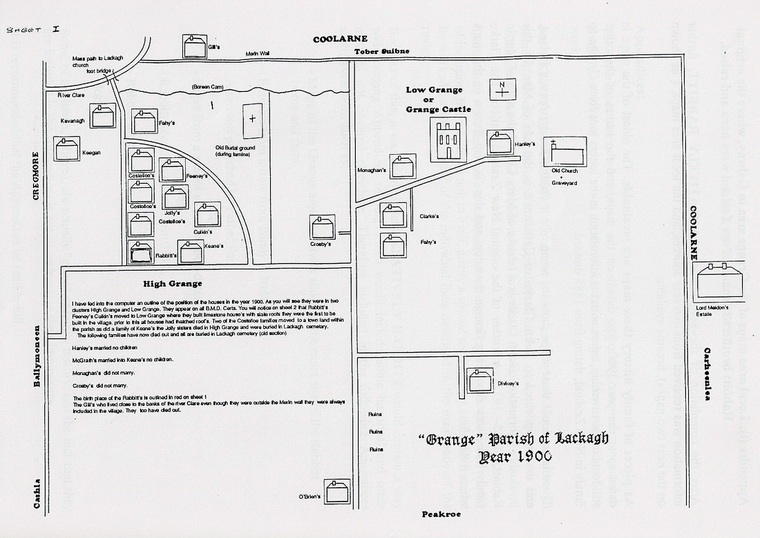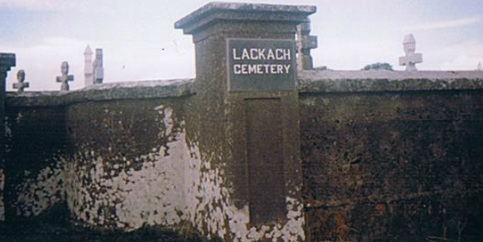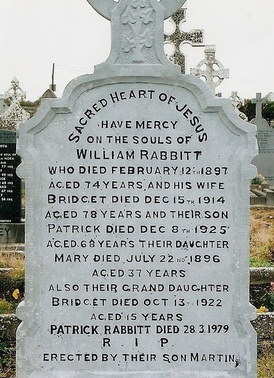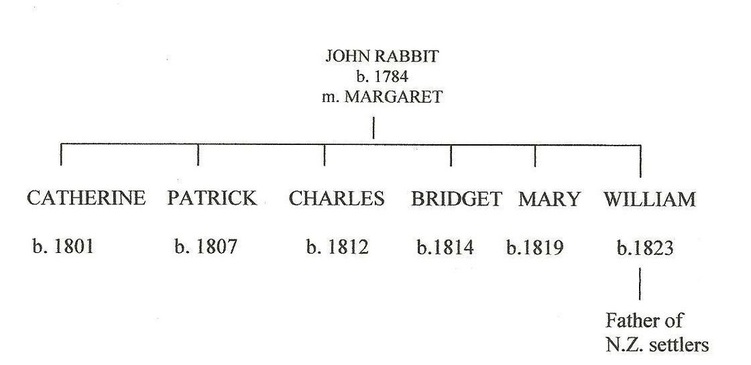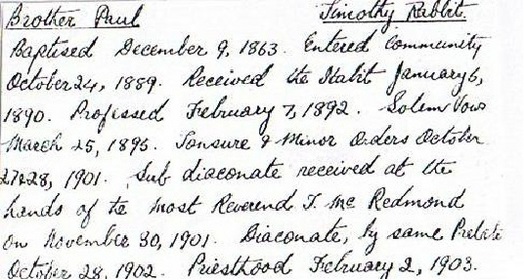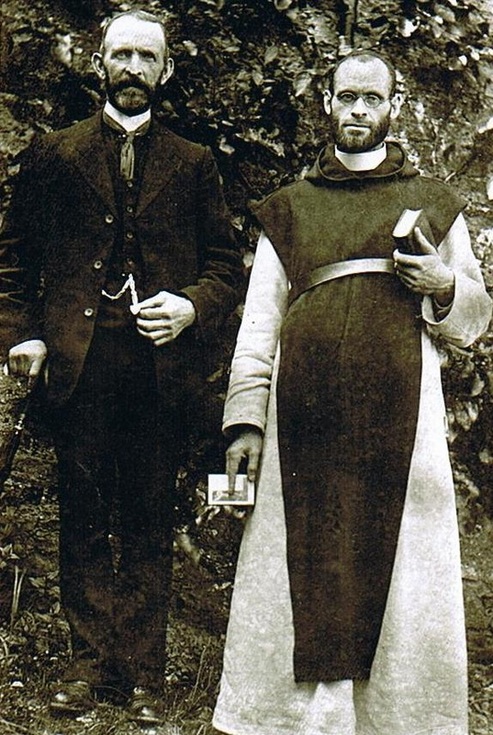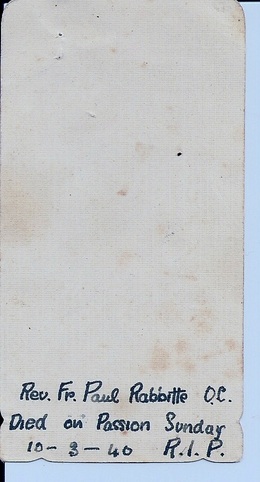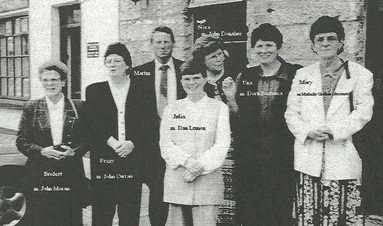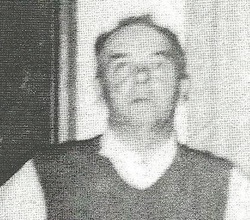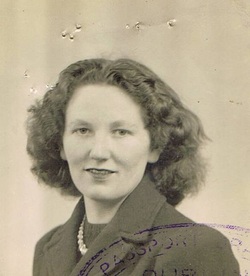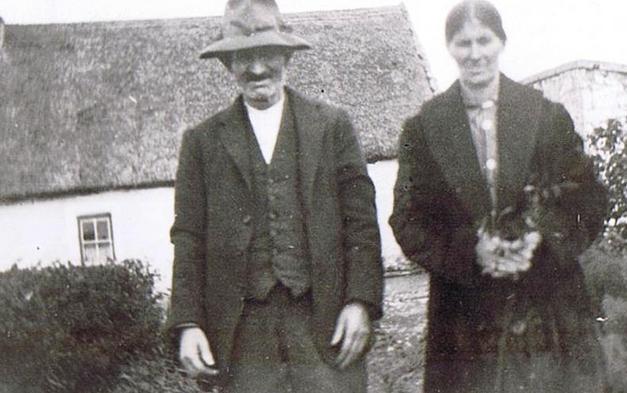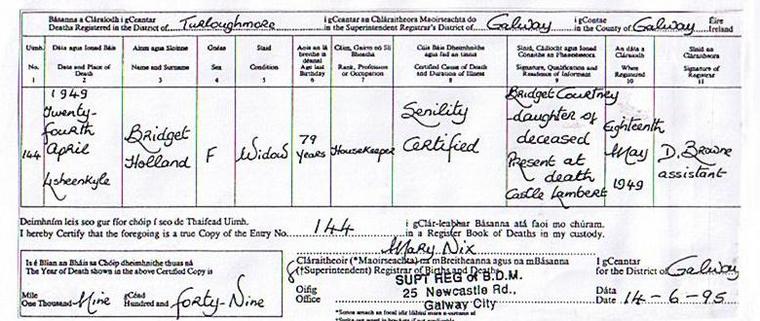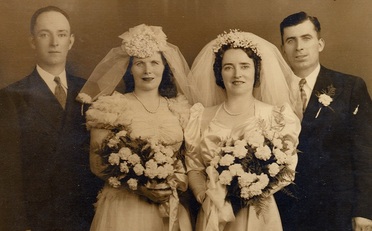The Family in Ireland
Parents of the New Zealand Settlers:
The parents of the three Rabbit brothers, who came to New Zealand, were William and Bridget Rabbit. They lived at Grange, which is about 12 miles inland from the coastal city of Galway. At Grange they farmed land leased from the landlord, and raised their family of seven children; 5 sons and 2 daughters. This local area map of Grange town-ship as it was about 1900 clearly shows the location of the house where William and Bridget Rabbit lived.
The parents of the three Rabbit brothers, who came to New Zealand, were William and Bridget Rabbit. They lived at Grange, which is about 12 miles inland from the coastal city of Galway. At Grange they farmed land leased from the landlord, and raised their family of seven children; 5 sons and 2 daughters. This local area map of Grange town-ship as it was about 1900 clearly shows the location of the house where William and Bridget Rabbit lived.
William Rabbit was born in Galway in 1823, and in line with common Irish practise, it is probable he was known as Liam. Official records always show the name as William. His occupation is recorded as a farmer. The Rabbit name is recorded in the 1828 tithes list, and as William was born in 1823, clearly he was not the first Rabbit family member to work land in the Grange area. Land ownership at the time was based on the landlord system, with use of the land leased to tenants. This system continued through William’s lifetime and it is unlikely William ever personally owned the land on which he worked.
Most of the older inhabitants of the Grange area spoke only Irish, and many were reluctant to accept the English language. The first schools in the area began about 1838, and the National School system educated children in English only. William would have been about 15 when the first school started in the district and it is unlikely he had any schooling. It is probable he spoke Irish only. William lived through the years of the Irish Famines, the worst of which occurred during the 1840/50 period, when William was in his early 20's.
Following the Irish trend of the time for males to marry later in life, William married Bridget, nee Golding, when he was 33 years old.
Most of the older inhabitants of the Grange area spoke only Irish, and many were reluctant to accept the English language. The first schools in the area began about 1838, and the National School system educated children in English only. William would have been about 15 when the first school started in the district and it is unlikely he had any schooling. It is probable he spoke Irish only. William lived through the years of the Irish Famines, the worst of which occurred during the 1840/50 period, when William was in his early 20's.
Following the Irish trend of the time for males to marry later in life, William married Bridget, nee Golding, when he was 33 years old.
Bridget Rabbitt (1836 - 1914)

Bridget Rabbitt (nee Golding)
1836 - 1914
Bridget Golding was born in Galway in 1836 approx, and was about 20 years old when she married William. The Golding family name is recorded in the early records of Lackagh parish, and Bridget is known to have had a sister named Mary. Letters from Ireland show Bridget as a hardy woman who raised seven children and who battled through the famines and other hardships of their time. Their seven children were born in the 17 year period from 1855 to 1873, and she was very proud of her family and their achievements. In the 1880’s William and Bridget saw the departure of their two oldest sons to New Zealand knowing it was unlikely they would see them again. Like many of their generation, William and Bridget would also see some of their grandchildren depart Ireland to make their life in the New World; i.e; in America and New Zealand. William died at Grange on 12 February 1897, at the age of 74 years. He is buried at the Lackagh - Old Graveyard; - plot 513.
Bridget outlived her husband by 17 years, and passed away at Grange on 15 December 1914. Her cause of death was chronic bronchitis, and she is buried with her husband at the Lackagh – Old Graveyard. There is conflicting evidence about her age – the graveyard record shows her as 78 years whereas the death registration shows the age as 80 years. The 1911 Census records show Bridget as Irish speaking only perhaps confirming William was also Irish speaking only.
Bridget outlived her husband by 17 years, and passed away at Grange on 15 December 1914. Her cause of death was chronic bronchitis, and she is buried with her husband at the Lackagh – Old Graveyard. There is conflicting evidence about her age – the graveyard record shows her as 78 years whereas the death registration shows the age as 80 years. The 1911 Census records show Bridget as Irish speaking only perhaps confirming William was also Irish speaking only.
The Lackagh Cemetery Headstone
The photos below are of the headstone on William and Bridget’s grave in the Lackagh Cemetery. The first photo shows the headstone when viewed in 1997. Later, family members in Ireland refurbished the headstone. Included on the headstone are references to other family members. Not all of the people named on the headstone are actually buried there. For example the son (Patrick), named on the headstone is buried in Clinton, New Zealand. We have been unable to verify if Mary is buried with her parents…. it is thought not. The granddaughter Bridget, named on the headstone, was the daughter of Martin .The second person named Patrick on the headstone, was a grandson – son of Martin.
First Cousin of Bridget Rabbit nee Golding
Two Irish sources indicate Bridget’s mother’s maiden name was McDonagh. The sources believe Bridget’s mother’s sister was Margaret McDonagh, who married Walter Burke. Margaret McDonagh and Walter Burke are the parents of Thomas Nicholas Burke (1830 – 1882), a celebrated Dominican priest, whose statue stands in Galway city. Details of this man’s life and a photo of his statue in Galway are included in the appendices.
Who were William’s ancestor’s?
Many earlier official Irish records were destroyed in a 1922 fire in the Dublin Public Records Office, and it may be impossible to officially prove the names of William’s parents. It is known William was born in “Galway” in 1823, and the 1828 Tithes List confirms adult people named Rabbit were living and working 102 acres of land in the Lackagh area in 1828. It is most likely these people were William’s ancestors, and it may be possible through reasoning to establish who his ancestors were. The following information provides some relevant facts.
(i) Christening records
The christening records of William and Bridget’s children show the names of Catherine Rabbit and Edward Rabbit as “sponsors”. It is reasonable to assume Catherine and Edward are related to William, are of adult age, and are of the same generation as William. Perhaps Edward was William’s brother, and Catherine was Edward’s wife? Or perhaps Catherine was William’s sister?
It should be noted an Edward Rabbit, and his brother of Timothy Rabbit, both of Galway emigrated to Dunedin, New Zealand, and Edward was in Dunedin from the 1860’s.
(ii) Rabbitt families living in the same area, at the same time:
There were at least three other Rabbitt families living in the Grange area at the same time as William and Bridget. It is likely the three families were related to William and Bridget because;
The families were living in the same district at a time when movement outside a radius of 20 miles was rare.
As occupiers of land, their circumstances would have been better than others, and family movement to other areas would not be necessary.
(iii) Naming Patterns
The child naming patterns of these families follow traditional Irish naming patterns and provide a significant clue to the nature of the family relationship. It was the practise for Irish families to name their first son after the child’s paternal grandfather. The fathers of the other three Rabbitt families living in the Grange area were named James, Patrick, and Charles Rabbitt. These three Rabbitt fathers all named their first son John. As William, the father of the NZ settlers, also named his first son John, this suggests James, Patrick, and Charles are brothers of William, and their fathers name was John.
The Grandparents of the New Zealand Settlers?
As William was born in 1823, the entry in the 1828 tithes must relate to Rabbit family who are at least one generation older than him. The previous section suggested the father of Patrick, Charles, James and William, was probably named John. The research has proven, the existence of a John Rabbit, who was born in Galway, in 1784, and like the Rabbit families of the Grange area, was the father of sons named Patrick, (born 1807), and Charles (born 1812). The following diagram shows the known family of this John Rabbit.
Additional evidence tending to confirm this includes;
(i ) The choice of the name Charles, is significant as it is a very rare name to find among Irish records. The fact that there was a Charles Rabbitt living in the Grange area, and at the right time, increases the probability of a direct relationship between these people.
(ii) Another important factor is that references to the John Rabbit (born 1784) always show the name spelt with only one "t". It is known that the New Zealand settlers at some stages spelt their name with one "t" and that only a small proportion of the Irish Rabbitt families spelt their name in this manner.
However, evidence regarding the spelling of the family needs to be carefully considered, as later information tends to suggest the spelling of the family name is very random; i.e.; there is little consistency, and what appears to be a pattern in the spelling of the name, can also change for no obvious reason.
Earlier Generations of the family in Ireland.
Acceptance of the earlier explanation, leads the family tree back an additional generation, as it is proven that the father of John (born 1784), was Thaddeus Rabbit born in Galway in 1751. This Thaddeus would be the grandfather of William, the father of the New Zealand settlers. Is it significant that William named his third son Timothy (Thaddeus) – perhaps after his grandfather?
Thaddeus was married in 1783, and produced a family of at least four sons (including John). Details of this family are shown hereunder;
Therefore, the strongly suggested family line leading directly to the three Rabbitt brothers who settled in New Zealand from 1879 onward is:
Obviously there is further Rabbitt family history to unearth in Ireland and other countries, going back beyond 1751. It will be an interesting history to uncover as there is much speculation about the history of the name before its appearance in Ireland.
Brothers and sisters of the New Zealand settlers:
Earlier in the review it was noted that the parents of the New Zealand settlers (William and Bridget) had seven children.
These seven children, in order of birth, are;
John born 1855
Patrick born 1858
Mary born 1859
Timothy (Thaddeus) born 1863
Martin born 1865
Bridget born 1868
William born 1873
The two eldest sons, (John and Patrick), left Ireland as single men, and arrived in New Zealand in 1879 and 1882 respectively. The youngest son, William, came to New Zealand with his young family in 1911.
(Full details of the lives of these three sons are included in the section entitled; "The First Generation in New Zealand".)
This review will now describe what is known of the lives of the brothers and sisters who did not come to New Zealand, and any information that is available about their particular families.
The family of William Rabbit and Bridget (nee Golding)
Mary Rabbit (1859 - 1896):
Mary was the first daughter of William and Bridget Rabbitt, of Grange. She was born in 1859, and christening records for Mary show the names of Bridget Glynn and Edmund Culkeene as the “sponsors”. There is conflicting evidence for Mary’s year of birth with some indications her birth may have been as late as 1863. It is likely the sponsors were friends or neighbours of Mary’s parents, as both the Glynn and Culkeene names were residents of the Grange area in the 1850’s.
Mary married John Corley on the 5th November 1882 when she was about 22 years of age. John’s parents were Patrick and Julia Corley, and Julia’s maiden name was Rooney. The 1901 Census shows some members of the Rooney family lived at the village of Coldwood, in County Galway. John and Mary Corley, nee Rabbitt were the parents of 8 children born over a 14 year period from 1882 until 1896. Their children were Mary, Patrick, Julia, Norah, Annie, Delia, William and Thomas. It is likely Mary, and John, raised their family at Coldwood in Galway.
Mary died suddenly on 22 July 1896 at 37 years of age. It is understood she died in an accident when she fell from a horse and cart being driven by her husband. At the time of her death some of Mary’s eight children were of a relatively young age with the eldest about 12, and the youngest approx two years of age. It is likely the caring for these children became a responsibility of the wider family, although that has not been proven.
Eventually all of these eight children went to America. Over time the Corley surname became changeable with the similar sounding surnames of Carley and Curley. These surname changes occurred with the family of Mary and John Corley, and while living in America some family members took additional Christian names, and it one case the Christian name has been changed.
After the death of his wife in 1896, John Corley, the father of the family of eight, went to America. His family remained in Galway. John Corley was living in America, in the Boston MASS area by 1900. Therefore he must have travelled to America sometime after the death of his wife in 1896, and before 1901. By the time of the 1901 Irish Census, five of Mary and John’s children are recorded as living in Coldwood, Stradbelly – Dunkellin Parish, Galway. They were:
Patrick (16) Head of Family
Julia (14) Housekeeper
Norah (11) Scholar
Willie (9) Scholar
Thomas (7) Scholar
The three members of the family who are not recorded living at Coldwood were; Mary who by then was aged about 17/18, Delia aged about 12, and Annie aged about 8. Mary, the oldest member had gone to America by 1900/1901, and Delia was living with her grandmother Bridget Rabbitt at Grange in 1901. No trace has been found of Annie at the time of the 1901 Census, but she was still in Ireland and most likely living with other family members. As all members of the family reached adult age, they went to America where they lived for the remainder of their lives.
Further details about the family of Mary (nee Rabbitt) and John Corley are;
Mary was the eldest of the family. She was born in Galway in 1882/83, and in 1900 at about age 18, she was the first member of the family to go to America. She travelled on the “Peruvian” which went from Galway to Boston. Mary’s travel was sponsored by her father, John Corley, who was then living at Beaver Brook, Waltham, MASS.
In America, on 8 August 1910, Mary married John Joseph Allen, at Newton, MASS. John was a painter and decorator. There were three children in their family; Mary A born 1912, Agnes M born 1913, and Ruth born 1917. In the1930 American Census, Mary aged about 46 is recorded living at Mill Street, Boston, along with her 22 year old youngest daughter – Ruth. There is no record of her husband or their 2 older daughters who would have been of independent age.
Patrick – the oldest son of the family was born in Galway in December 1884. He is recorded living in Coldwood at the time of the 1901 census and again the 1911 census. By 1911 he was 27 years of age, and no other members of the family were living with him. Later that year he travelled to America on the Muritania. He was “sponsored” to America by his sister Mary and his fare was paid by his father. In 1915, the year his younger brothers arrived in America, Patrick was living at 92 Russel Street. Malden, MASS.
Patrick married Julia Greely on the 23 April 1916 at Malden in Mass. Their first child Patrick J was born in August 1917. In the 1920 census Patrick was living at 108 Whitman St, Malden with his wife and son. He was employed as a Iron Worker. His youngest brother Thomas was also living there with him. Patrick and Julia had a second child, - Thomas, born on the 8 June 1920. Unfortunately baby Thomas lived for only 2 days and Patrick’s wife also died 4 days later on the 14 June 1920. Both mother and child are buried at the Holy Cross Cemetery, Malden, Mass.
Patrick married again in 1922 to Mary Driscoll. There is no evidence of any further children.
Julia was the third child of Mary Rabbitt and John Corley and she was born in County Galway in 1887. It is very probable she was named after her paternal grandmother Julia Corley – nee Rooney. She was recorded on the 1901 census as being a 14 year old housekeeper living with some of her brothers and sisters, in Coldwood, Galway. In 1903, when aged about 16, she went to America to her older sister, Mary, who was living at Beaver Brook, Waltham MASS. Julia travelled on the s s “Commonwealth” which departed Queenstown (Ireland) on 22 May 1903, travelling to Boston. There is no additional information about Julia, until nine years later when in 1912, she married Arthur Pierre Rinfret. There were at least 2 sons in their family – Arthur Pierre ( Jnr) born 14 October 1913, and Llewellyn Curley Rinfret, who was born on 30 Jan 1916 in New York. In the1930 Census Julia is recorded living at 1856 Stewart St in New York. It is likely that in America Julia took a second given name (Anne) as this name is used on some official documents. Julia died on 17 March 1939 while living at 708 Ocean Ave, Kings County, New York. She is buried at West Medford (MASS) – Oak Road Cemetery.
Delia was born 12 October 1889 in Co Galway. In 1901 census Delia was recorded as age 12 and living with her Maternal Grandmother Bridget Rabbitt in Grange. Delia went to America in 1906 and on the 23 April 1916 she married John E Gilleland in Malden Mass. This was the same date and place as where her older brother Patrick was married. John Gilleland was a train conductor. Delia and John had three sons, John E born 3 Jan 1918, Leo Francis born 4 Sept 1919 and Vincent P born 16 Dec 1921. In 1919, Delia’s husbands occupation was shown as a Ships Fitter.
It seems likely that in America, Delia used a second given name - Agnes. This appears on some official records. From 1930 to 1946 Delia and John were living at 38 Cherry Street Medford Mass, where John was a Manager of a General Store and they owned their own home. Their youngest son Vincent died 24 Dec 2005 at Coeur d’ Alene Idaho.Delia died on 1 June 1977 at Medford, MASS.
Nora was born in Galway and about 1906 she travelled to America – originally living in the Boston area. In the 1910 Census she is recorded as living in New York. There is no further evidence of Nora. On 27 March 1910 a person named Maria Corley married Joseph Walsh in Manhattan, New York. On the marriage certificate this Maria Corley gave her parents names as John Corley, and Mary Rabbitt. As there is no earlier evidence of Maria, and no later evidence of Nora, it seems logical to conclude, they are the same person. There was a trend for Irish females to take more “American like” names, and this seems to have happened in this case. Maria and Joseph are recorded in the 1920 Census living at Calumet, Indiana. There were at least 5 children of this marriage; - they were; - Anna born c. 1915, John born c 1917, Josephine born c.1926, Helen born 1930, and Mary born 1932.
William was born in 1893 in Galway, and was among the last members of this family to emigrate to America. He travelled on the Cymric which arrived in America on 7 April 1915. William’s younger brother Thomas also travelled on the same journey. William went to live with his older brother Patrick, who at that stage was living at 92 Russel Street, Malden, MASS. In America it seems likely William took a second given name as some official documents refer to him as William Patrick Corley. On 27 November 1918, William married Norah Teahan. In the 1920 American Census William and Norah are recorded living in Malden, MASS. There were three children of this marriage;
William Patrick Curley (1920 – 1920),
John Joseph Curley (1921 – 1978). This man served in the Army and married Katherine Agnes O’Neill ( 1923 – 2006) in Portsmouth, Virginia. There were 6 children of their marriage. They were Nancy, Carole, John, Richard, Eileen, and Marisha . John and Katherine are buried at Pine Ridge Cemetery in Chelsmford, MASS.
Margaret ( Mary) Teresa Curley ( 1923 – 2016). Margaret, known as Mary, married Richard James McArdle ( 1918 – 1964). There is a child, named Joan Marie McArdle.
William, the father of this family, died on 14 Jan 1926, following an accident on a construction site. He was struck by a steam shovel, and his injuries included a mangled right arm and a fractured knee.
He is buried at the Oak Grove Cemetery in Medford. His wife remarried.
Thomas was the eighth and final member of the family of Mary nee Rabbitt and John Corley. He was their third son, and was born about 1894. There is conflicting evidence about his date of birth, however he is shown as a 7 year old, in the 1901 Census, and therefore the year of 1894 is most likely to be correct. There is no trace of Thomas on the 1911 Census, when he would have been about 17 years of age. In 1915 Thomas travelled to America with his older brother William. Thomas and William travelled to America on the Cymric which arrived on 7 April 1915. On arrival he was living with his oldest brother Patrick, at 92 Russel Street, Molden MASS. In America it is probable he took the second given name of Joseph as this is shown on some official documents.
Thomas married Annie Teresa Lundy at Medford, MASS in 1922. Thomas and Annie were the parents of at least three children; - Thomas J born 1923, Theodore born 27 August 1925, and Arthur A born 2 July 1922,
Annie was born in 1892 in Galway. There is no record of her in the 1901 Irish Census. In the 1911 Irish census she is shown as an 18 year old living at House 2 Church Street, Athenry, Galway. This was the home of John Brodrick a builder, and Annie is shown as a servant, at this house.
She went to America and on 24 November 1915, she married James Frances Murphy at Malden MASS. James was a conductor. There was a least one child of this marriage – James Francis Jnr who was born on 16 August 1916. In 1920 Annie wrote to family members in New Zealand and invited them to have a holiday with her in America. While this did not happen, the survival of the correspondence did provide an important confirmation of the linkage with this branch of the New Zealand family. In her 1920 letter Annie confirmed that all members of the Corley family were living in America by that time. She also wrote of her recent holiday at “Rockaway Beach”, where she stayed for several weeks. At that time her sister Julia was living at Rockaway Beach providing further confirmation of the family connection.
It is likely while living in America Annie took a second Christian name of Josephine, as this name appears on some official documents. Her son James Francis Murphy (Jnr) married Ruth Margaret Currie, and he died in 1997.
John Corley the father of this family went to America some time after the death of his wife Mary nee Rabbit in 1896. He was in America by the time of the arrival of his eldest daughter Mary in 1900. He remained living in the Waltham, Boston MASS area. He married twice more in America and died in 1914.
Members of the Holland family in Ireland remember a visit from members of the Corley family from America, in 1968. A photo at the time of this visit is included in the section about the family of John Holland. Despite lengthy research it has not yet been possible to find the trail leading to descendants of this family.
Mary was the first daughter of William and Bridget Rabbitt, of Grange. She was born in 1859, and christening records for Mary show the names of Bridget Glynn and Edmund Culkeene as the “sponsors”. There is conflicting evidence for Mary’s year of birth with some indications her birth may have been as late as 1863. It is likely the sponsors were friends or neighbours of Mary’s parents, as both the Glynn and Culkeene names were residents of the Grange area in the 1850’s.
Mary married John Corley on the 5th November 1882 when she was about 22 years of age. John’s parents were Patrick and Julia Corley, and Julia’s maiden name was Rooney. The 1901 Census shows some members of the Rooney family lived at the village of Coldwood, in County Galway. John and Mary Corley, nee Rabbitt were the parents of 8 children born over a 14 year period from 1882 until 1896. Their children were Mary, Patrick, Julia, Norah, Annie, Delia, William and Thomas. It is likely Mary, and John, raised their family at Coldwood in Galway.
Mary died suddenly on 22 July 1896 at 37 years of age. It is understood she died in an accident when she fell from a horse and cart being driven by her husband. At the time of her death some of Mary’s eight children were of a relatively young age with the eldest about 12, and the youngest approx two years of age. It is likely the caring for these children became a responsibility of the wider family, although that has not been proven.
Eventually all of these eight children went to America. Over time the Corley surname became changeable with the similar sounding surnames of Carley and Curley. These surname changes occurred with the family of Mary and John Corley, and while living in America some family members took additional Christian names, and it one case the Christian name has been changed.
After the death of his wife in 1896, John Corley, the father of the family of eight, went to America. His family remained in Galway. John Corley was living in America, in the Boston MASS area by 1900. Therefore he must have travelled to America sometime after the death of his wife in 1896, and before 1901. By the time of the 1901 Irish Census, five of Mary and John’s children are recorded as living in Coldwood, Stradbelly – Dunkellin Parish, Galway. They were:
Patrick (16) Head of Family
Julia (14) Housekeeper
Norah (11) Scholar
Willie (9) Scholar
Thomas (7) Scholar
The three members of the family who are not recorded living at Coldwood were; Mary who by then was aged about 17/18, Delia aged about 12, and Annie aged about 8. Mary, the oldest member had gone to America by 1900/1901, and Delia was living with her grandmother Bridget Rabbitt at Grange in 1901. No trace has been found of Annie at the time of the 1901 Census, but she was still in Ireland and most likely living with other family members. As all members of the family reached adult age, they went to America where they lived for the remainder of their lives.
Further details about the family of Mary (nee Rabbitt) and John Corley are;
Mary was the eldest of the family. She was born in Galway in 1882/83, and in 1900 at about age 18, she was the first member of the family to go to America. She travelled on the “Peruvian” which went from Galway to Boston. Mary’s travel was sponsored by her father, John Corley, who was then living at Beaver Brook, Waltham, MASS.
In America, on 8 August 1910, Mary married John Joseph Allen, at Newton, MASS. John was a painter and decorator. There were three children in their family; Mary A born 1912, Agnes M born 1913, and Ruth born 1917. In the1930 American Census, Mary aged about 46 is recorded living at Mill Street, Boston, along with her 22 year old youngest daughter – Ruth. There is no record of her husband or their 2 older daughters who would have been of independent age.
Patrick – the oldest son of the family was born in Galway in December 1884. He is recorded living in Coldwood at the time of the 1901 census and again the 1911 census. By 1911 he was 27 years of age, and no other members of the family were living with him. Later that year he travelled to America on the Muritania. He was “sponsored” to America by his sister Mary and his fare was paid by his father. In 1915, the year his younger brothers arrived in America, Patrick was living at 92 Russel Street. Malden, MASS.
Patrick married Julia Greely on the 23 April 1916 at Malden in Mass. Their first child Patrick J was born in August 1917. In the 1920 census Patrick was living at 108 Whitman St, Malden with his wife and son. He was employed as a Iron Worker. His youngest brother Thomas was also living there with him. Patrick and Julia had a second child, - Thomas, born on the 8 June 1920. Unfortunately baby Thomas lived for only 2 days and Patrick’s wife also died 4 days later on the 14 June 1920. Both mother and child are buried at the Holy Cross Cemetery, Malden, Mass.
Patrick married again in 1922 to Mary Driscoll. There is no evidence of any further children.
Julia was the third child of Mary Rabbitt and John Corley and she was born in County Galway in 1887. It is very probable she was named after her paternal grandmother Julia Corley – nee Rooney. She was recorded on the 1901 census as being a 14 year old housekeeper living with some of her brothers and sisters, in Coldwood, Galway. In 1903, when aged about 16, she went to America to her older sister, Mary, who was living at Beaver Brook, Waltham MASS. Julia travelled on the s s “Commonwealth” which departed Queenstown (Ireland) on 22 May 1903, travelling to Boston. There is no additional information about Julia, until nine years later when in 1912, she married Arthur Pierre Rinfret. There were at least 2 sons in their family – Arthur Pierre ( Jnr) born 14 October 1913, and Llewellyn Curley Rinfret, who was born on 30 Jan 1916 in New York. In the1930 Census Julia is recorded living at 1856 Stewart St in New York. It is likely that in America Julia took a second given name (Anne) as this name is used on some official documents. Julia died on 17 March 1939 while living at 708 Ocean Ave, Kings County, New York. She is buried at West Medford (MASS) – Oak Road Cemetery.
Delia was born 12 October 1889 in Co Galway. In 1901 census Delia was recorded as age 12 and living with her Maternal Grandmother Bridget Rabbitt in Grange. Delia went to America in 1906 and on the 23 April 1916 she married John E Gilleland in Malden Mass. This was the same date and place as where her older brother Patrick was married. John Gilleland was a train conductor. Delia and John had three sons, John E born 3 Jan 1918, Leo Francis born 4 Sept 1919 and Vincent P born 16 Dec 1921. In 1919, Delia’s husbands occupation was shown as a Ships Fitter.
It seems likely that in America, Delia used a second given name - Agnes. This appears on some official records. From 1930 to 1946 Delia and John were living at 38 Cherry Street Medford Mass, where John was a Manager of a General Store and they owned their own home. Their youngest son Vincent died 24 Dec 2005 at Coeur d’ Alene Idaho.Delia died on 1 June 1977 at Medford, MASS.
Nora was born in Galway and about 1906 she travelled to America – originally living in the Boston area. In the 1910 Census she is recorded as living in New York. There is no further evidence of Nora. On 27 March 1910 a person named Maria Corley married Joseph Walsh in Manhattan, New York. On the marriage certificate this Maria Corley gave her parents names as John Corley, and Mary Rabbitt. As there is no earlier evidence of Maria, and no later evidence of Nora, it seems logical to conclude, they are the same person. There was a trend for Irish females to take more “American like” names, and this seems to have happened in this case. Maria and Joseph are recorded in the 1920 Census living at Calumet, Indiana. There were at least 5 children of this marriage; - they were; - Anna born c. 1915, John born c 1917, Josephine born c.1926, Helen born 1930, and Mary born 1932.
William was born in 1893 in Galway, and was among the last members of this family to emigrate to America. He travelled on the Cymric which arrived in America on 7 April 1915. William’s younger brother Thomas also travelled on the same journey. William went to live with his older brother Patrick, who at that stage was living at 92 Russel Street, Malden, MASS. In America it seems likely William took a second given name as some official documents refer to him as William Patrick Corley. On 27 November 1918, William married Norah Teahan. In the 1920 American Census William and Norah are recorded living in Malden, MASS. There were three children of this marriage;
William Patrick Curley (1920 – 1920),
John Joseph Curley (1921 – 1978). This man served in the Army and married Katherine Agnes O’Neill ( 1923 – 2006) in Portsmouth, Virginia. There were 6 children of their marriage. They were Nancy, Carole, John, Richard, Eileen, and Marisha . John and Katherine are buried at Pine Ridge Cemetery in Chelsmford, MASS.
Margaret ( Mary) Teresa Curley ( 1923 – 2016). Margaret, known as Mary, married Richard James McArdle ( 1918 – 1964). There is a child, named Joan Marie McArdle.
William, the father of this family, died on 14 Jan 1926, following an accident on a construction site. He was struck by a steam shovel, and his injuries included a mangled right arm and a fractured knee.
He is buried at the Oak Grove Cemetery in Medford. His wife remarried.
Thomas was the eighth and final member of the family of Mary nee Rabbitt and John Corley. He was their third son, and was born about 1894. There is conflicting evidence about his date of birth, however he is shown as a 7 year old, in the 1901 Census, and therefore the year of 1894 is most likely to be correct. There is no trace of Thomas on the 1911 Census, when he would have been about 17 years of age. In 1915 Thomas travelled to America with his older brother William. Thomas and William travelled to America on the Cymric which arrived on 7 April 1915. On arrival he was living with his oldest brother Patrick, at 92 Russel Street, Molden MASS. In America it is probable he took the second given name of Joseph as this is shown on some official documents.
Thomas married Annie Teresa Lundy at Medford, MASS in 1922. Thomas and Annie were the parents of at least three children; - Thomas J born 1923, Theodore born 27 August 1925, and Arthur A born 2 July 1922,
Annie was born in 1892 in Galway. There is no record of her in the 1901 Irish Census. In the 1911 Irish census she is shown as an 18 year old living at House 2 Church Street, Athenry, Galway. This was the home of John Brodrick a builder, and Annie is shown as a servant, at this house.
She went to America and on 24 November 1915, she married James Frances Murphy at Malden MASS. James was a conductor. There was a least one child of this marriage – James Francis Jnr who was born on 16 August 1916. In 1920 Annie wrote to family members in New Zealand and invited them to have a holiday with her in America. While this did not happen, the survival of the correspondence did provide an important confirmation of the linkage with this branch of the New Zealand family. In her 1920 letter Annie confirmed that all members of the Corley family were living in America by that time. She also wrote of her recent holiday at “Rockaway Beach”, where she stayed for several weeks. At that time her sister Julia was living at Rockaway Beach providing further confirmation of the family connection.
It is likely while living in America Annie took a second Christian name of Josephine, as this name appears on some official documents. Her son James Francis Murphy (Jnr) married Ruth Margaret Currie, and he died in 1997.
John Corley the father of this family went to America some time after the death of his wife Mary nee Rabbit in 1896. He was in America by the time of the arrival of his eldest daughter Mary in 1900. He remained living in the Waltham, Boston MASS area. He married twice more in America and died in 1914.
Members of the Holland family in Ireland remember a visit from members of the Corley family from America, in 1968. A photo at the time of this visit is included in the section about the family of John Holland. Despite lengthy research it has not yet been possible to find the trail leading to descendants of this family.
The above photo is of Mary’s daughter Julia Corley, and was provided by a cousin in New Zealand.
As it has not been possible to positively identify a photograph of Mary Corley (nee Rabbitt), an example of her handwriting is shown under. This is taken from a letter to her brothers in New Zealand written in 1883.
As it has not been possible to positively identify a photograph of Mary Corley (nee Rabbitt), an example of her handwriting is shown under. This is taken from a letter to her brothers in New Zealand written in 1883.
Translation:
“I am your truly sister Mary no more to say, Father and Mother Brother and sisters Blessing and their kind love
Write as soon as you will handel this letter.
Don’t for get writeing when you get this letter and let us know is your self and Pat near one another yet.”
“I am your truly sister Mary no more to say, Father and Mother Brother and sisters Blessing and their kind love
Write as soon as you will handel this letter.
Don’t for get writeing when you get this letter and let us know is your self and Pat near one another yet.”
Timothy Rabbit: (1863 - 1940)
(Father Paul)
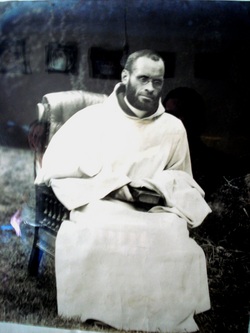
Timothy was the third of the five sons of William and Bridget. He was born at Turloughmore in late in 1863, and baptised on 9 December, 1863. The sponsors were James Culkeen and Mary White.
Like his older brothers, as a young man Timothy (or Thaddy as he was known in the family), assisted on the family farm at Turloughmore. In a letter to her New Zealand brothers, dated 1 October 1885, one of Timothy’s sisters wrote that "Thaddy has gone to the monks". This is taken to mean that Timothy has joined with the monks of the Cistercian Order, in the new monastery at Roscrea, in County Tipperary. The monastery is called Mount St. Joseph Abbey, and opened about 1878/79. By October 1885, Timothy would have been 21 years of age, and considering that by this time both his older brothers had gone to New Zealand to live, the sending of their third son to the church was a considerable sacrifice by the family. The following is a hand written record of Timothy's progress through the initial stages of his life in the church. (This detail has been obtained from records at the monastery).
Like his older brothers, as a young man Timothy (or Thaddy as he was known in the family), assisted on the family farm at Turloughmore. In a letter to her New Zealand brothers, dated 1 October 1885, one of Timothy’s sisters wrote that "Thaddy has gone to the monks". This is taken to mean that Timothy has joined with the monks of the Cistercian Order, in the new monastery at Roscrea, in County Tipperary. The monastery is called Mount St. Joseph Abbey, and opened about 1878/79. By October 1885, Timothy would have been 21 years of age, and considering that by this time both his older brothers had gone to New Zealand to live, the sending of their third son to the church was a considerable sacrifice by the family. The following is a hand written record of Timothy's progress through the initial stages of his life in the church. (This detail has been obtained from records at the monastery).
It seems Timothy spend some time in other religious institutions before entering Roscrea, in 1889. He was initially known in this institution as Brother Paul, and he spent the next thirteen years studying in preparation for his ordination as a priest.
His ordination, in 1903, was attended by his younger brother, Martin, and his sister Bridget. In writing about the ordination, Bridget described the Abbey as; "as a fine a place as you could wish to see."
His ordination, in 1903, was attended by his younger brother, Martin, and his sister Bridget. In writing about the ordination, Bridget described the Abbey as; "as a fine a place as you could wish to see."
After his ordination Timothy was known as Father Paul, and he spent the remaining 40 years of his life faithfully following the sometimes severe rulesof the church, and seeing the Abbey grow from small beginnings to magnificent proportions.
He was a very popular preacher, and from his ordination in 1903, he always preached on St. Patrick’s Day, in both Irish and English. The secret of his success was sincerity rather than eloquence. He had a large circle of friends, for he had a wonderful gift of sympathy, and like his patron, St Paul; he made himself all things to all men. He was also a zealous promoter of the Irish language as a well as an ardent patriot. But first and foremost he was a fervent monk and a holy priest.
An interesting anecdote about Father Paul was told to the authors’ by a priest at the Abbey at Roscrea, who knew of Father Paul and who told the following story; “In earlier times the strict rules of the Cistercian Order forbade speaking for lengthy periods, and the monks developed methods of communication by "signs". Father Paul's sign for introducing himself was to extend one arm, and using the fingers of his other arm, "hop" up his arm from his wrist to his shoulder. This "hopping" movement was to indicate his name as; Rabbit.
It is also said Father Paul was his known ability to “perform miracles”. It is not known what form these took but an elderly monk told the authors in 1997 that it was still known by the monks that Fr Paul could work miracles and once cured an injured child after the family had asked him to pray for the child.
There exists a very interesting letter written by Father Paul, from the Abbey at Roscrea, to his nephew Patrick James Rabbitte (1896 - 1962), in New Zealand. This letter, written in July 1921, shows something of the character of the man, and is included, in full, among the appendices to this review. The following brief extract from that letter is included at this stage to give an example of his handwriting, and also to give some indication of his commitment to the Irish Home Rule cause.
He was a very popular preacher, and from his ordination in 1903, he always preached on St. Patrick’s Day, in both Irish and English. The secret of his success was sincerity rather than eloquence. He had a large circle of friends, for he had a wonderful gift of sympathy, and like his patron, St Paul; he made himself all things to all men. He was also a zealous promoter of the Irish language as a well as an ardent patriot. But first and foremost he was a fervent monk and a holy priest.
An interesting anecdote about Father Paul was told to the authors’ by a priest at the Abbey at Roscrea, who knew of Father Paul and who told the following story; “In earlier times the strict rules of the Cistercian Order forbade speaking for lengthy periods, and the monks developed methods of communication by "signs". Father Paul's sign for introducing himself was to extend one arm, and using the fingers of his other arm, "hop" up his arm from his wrist to his shoulder. This "hopping" movement was to indicate his name as; Rabbit.
It is also said Father Paul was his known ability to “perform miracles”. It is not known what form these took but an elderly monk told the authors in 1997 that it was still known by the monks that Fr Paul could work miracles and once cured an injured child after the family had asked him to pray for the child.
There exists a very interesting letter written by Father Paul, from the Abbey at Roscrea, to his nephew Patrick James Rabbitte (1896 - 1962), in New Zealand. This letter, written in July 1921, shows something of the character of the man, and is included, in full, among the appendices to this review. The following brief extract from that letter is included at this stage to give an example of his handwriting, and also to give some indication of his commitment to the Irish Home Rule cause.
If further evidence is needed of Father Paul's commitment to the cause of Irish Home Rule, the appendices include full texts of a sermon preached by him. This sermon was given by Father Paul, on the Sunday after Dublin Castle was captured in the uprising.
Timothy Rabbit, (Father Paul); was quite obviously a man of some determination and strength of character. This, plus his love of Ireland, and his commitment to his religion, comes through in his writings.
(Full details of the above letter and the sermon are included in the appendices.)
The following is an extremely valuable picture of Father Paul, with his oldest brother John. As there is no suggestion that Father Paul ever came to New Zealand, this photograph can be taken as proof, that his brother John made at least one return visit to his family in Ireland.
The photograph is believed to have taken about 1909.
Timothy Rabbit, (Father Paul); was quite obviously a man of some determination and strength of character. This, plus his love of Ireland, and his commitment to his religion, comes through in his writings.
(Full details of the above letter and the sermon are included in the appendices.)
The following is an extremely valuable picture of Father Paul, with his oldest brother John. As there is no suggestion that Father Paul ever came to New Zealand, this photograph can be taken as proof, that his brother John made at least one return visit to his family in Ireland.
The photograph is believed to have taken about 1909.
Two small pieces of his priestly habit were also sent to New Zealand, and these are remembered by members of the family. Below is a copy of the memorial Card sent with one of the small pieces of his habit to his great nephew in Invercargill.
Father Paul died in Dublin on Passion Sunday, 10 March 1940, at 2.00pm in the afternoon. On his death, messages of sympathy were received from Members of Parliament and other prominent people throughout Ireland. His funeral was attended by priests, senators, county representatives, Members of Parliament, and the general public. The picture shows the cross over his grave in the grounds of the Mount St. Joseph's Abbey at Roscrea.
The words on the cross are;
NONNUS PAULUS SACERDOS
OBIT DIE 10 MARTH 1940 R.I.P
In Timothy (Father Paul), the Rabbitt family can proudly claim an individual who made an outstanding contribution to his time, and to the society in which he lived. Even as this review was being researched, more than 50 years after his death, he was still well remembered at the Abbey at Roscrea. He was greatly respected by all who knew him and was a much loved member of the Rabbitt family, both in Ireland and New Zealand.
When the authors visited Mount St Joseph in 1997 they were welcomed into the Churchyard by an elderly monk who remembered Father Paul and related the story earlier mentioned about him working “miracles”. He also told of there being a room in the house that had been used by Father Paul that contained some of his books and copies of his sermons. The monk also mentioned that Father Paul was very well thought of and the proximity of his grave to the Church indicated his importance to the community. Prayers were said at his grave and also at the grave of his nephew Brother Enda.
Also included in the appendices is a four page summary of Father Paul’s monastic life written by a man who was later to become the Abbot at St Joseph’s Abbey. This is a remarkable document which summarises the religious life of a man who during his lifetime and in the years following, has become something of a legend in the family.
NONNUS PAULUS SACERDOS
OBIT DIE 10 MARTH 1940 R.I.P
In Timothy (Father Paul), the Rabbitt family can proudly claim an individual who made an outstanding contribution to his time, and to the society in which he lived. Even as this review was being researched, more than 50 years after his death, he was still well remembered at the Abbey at Roscrea. He was greatly respected by all who knew him and was a much loved member of the Rabbitt family, both in Ireland and New Zealand.
When the authors visited Mount St Joseph in 1997 they were welcomed into the Churchyard by an elderly monk who remembered Father Paul and related the story earlier mentioned about him working “miracles”. He also told of there being a room in the house that had been used by Father Paul that contained some of his books and copies of his sermons. The monk also mentioned that Father Paul was very well thought of and the proximity of his grave to the Church indicated his importance to the community. Prayers were said at his grave and also at the grave of his nephew Brother Enda.
Also included in the appendices is a four page summary of Father Paul’s monastic life written by a man who was later to become the Abbot at St Joseph’s Abbey. This is a remarkable document which summarises the religious life of a man who during his lifetime and in the years following, has become something of a legend in the family.
Family members whose names appear among the chief mourners in the article are;
Mrs Holland - this is Timothy's younger sister; Bridget.
Mrs C Courtney - Timothy's niece: married daughter of Bridget.
Mr C.Courtney husband of Timothy's niece.
Mrs Martyn - Timothy's niece: married daughter of Bridget.
Mr J.Holland Timothy's nephew; son of Bridget.
Miss M Rabbette - Timothy's niece; daughter of Martin (deceased)
Mr M Rabbette - Timothy's nephew; son of Martin (deceased)
Mr P Clarke - Relative of Martin’s wife
Other relatives named in the Connaught Tribune article are; Miss Rose Scully, Miss B.Feeney, Mr K.Feeney, and Sergeant and Mrs Lynch. It is not clear what relationship these people had with Timothy, (Father Paul), but some reasoning has been applied as under;
(i) Timothy's oldest brother John (living in New Zealand) married Mary Scully, originally from Galway, so it is likely the Rose Scully referred to is a member of that family.
(ii) Timothy's youngest brother William, married Honoria Fahey from Grange, and as the names Fahey and Feeney are often synonymous in Ireland, it may be that the B.Feeney, and Mr K.Feeney referred to, are members of that family.
Martin Rabbitt: (1865 - 1932)
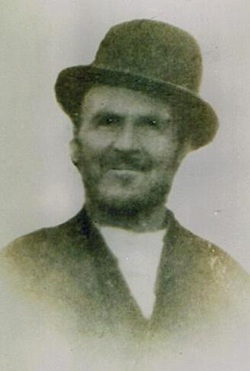
Martin was the fourth of the five sons of William and Bridget Rabbitt, (nee Golding), and he was born at Grange on 5 November 1865. Christening records show the names of his sponsors as Mary Golding and William Feeney. Mary Golding was Martin’s aunt (his mother’s sister) and William Feeney, was a Grange neighbour of the Rabbitt family.
With the departures of his older brothers, (John and Patrick) to New Zealand, and his next eldest brother Timothy, (Father Paul); to the monastery at Roscrea, Martin became the eldest son living in the district. He remained to help his father, on the land at Grange/Turloughmore. This illustrates the point that life in Ireland at this time (1880/1890) was still quite hard, and families were often separated by the necessity to make a new life elsewhere.
After the death of his father, in February 1897, the landlord system of land ownership changed and Martin became fully responsible for the land. In keeping with the pattern of Irish men not to marry until later in life, Martin did not marry until he was 34 years of age.
On 30 October 1899, Martin married Mary Clarke, who was also a resident of the Grange district. Witnesses at the wedding were Michael Hurney and Margaret Clarke, a sister of the bride.
With the departures of his older brothers, (John and Patrick) to New Zealand, and his next eldest brother Timothy, (Father Paul); to the monastery at Roscrea, Martin became the eldest son living in the district. He remained to help his father, on the land at Grange/Turloughmore. This illustrates the point that life in Ireland at this time (1880/1890) was still quite hard, and families were often separated by the necessity to make a new life elsewhere.
After the death of his father, in February 1897, the landlord system of land ownership changed and Martin became fully responsible for the land. In keeping with the pattern of Irish men not to marry until later in life, Martin did not marry until he was 34 years of age.
On 30 October 1899, Martin married Mary Clarke, who was also a resident of the Grange district. Witnesses at the wedding were Michael Hurney and Margaret Clarke, a sister of the bride.
Mary, who was born on 11 April 1869, was the daughter of John and Honor Clarke of Grange. The Clarke family were neighbours of the Rabbitt’s. Shortly after their marriage in 1899, Martin and Mary, went to America, and lived there for a reasonably short time. The first member of their family (John) was born in America; about 1901/02. The move to America, did not last and by 1904 Martin and Mary had resumed life in the Grange area of Galway. (It is known that the trunk which Martin and his family used on their return journey from America is still with the family in Ireland).
Martin and Mary had the following family;
John
William
Timothy (Br. Enda),
Bridget
Mary
Nora
Patrick
Martin (Jnr) (known as Mattie)
John Clarke of the Isle of Man, and Thomas Costelloe of Turloughmore provided information about the photograph below. The original home of the family of Thomas Costelloe was adjacent to the Rabbitt family home, and Thomas remembered the dog, (barely visible between the women, second and third from the left), was called Sweep!
The photograph, which was probably taken about 1919, has been in Rabbitt family possession in New Zealand and the original is of a very poor quality. Through the use of technology it was been possible to enhance the picture and the result is the above remarkable piece of family history.
Martin and Mary had the following family;
John
William
Timothy (Br. Enda),
Bridget
Mary
Nora
Patrick
Martin (Jnr) (known as Mattie)
John Clarke of the Isle of Man, and Thomas Costelloe of Turloughmore provided information about the photograph below. The original home of the family of Thomas Costelloe was adjacent to the Rabbitt family home, and Thomas remembered the dog, (barely visible between the women, second and third from the left), was called Sweep!
The photograph, which was probably taken about 1919, has been in Rabbitt family possession in New Zealand and the original is of a very poor quality. Through the use of technology it was been possible to enhance the picture and the result is the above remarkable piece of family history.
Martin Rabbitt Snr died of “acute cardiac failure”, at Grange, Turloughmore, on 16 October 1932. He was aged 67 years. Martin died quite suddenly, and his daughter Mary, (married name Mannion), was present when he passed away. The following is a copy of the certificate issued upon his death;
See the extract below from a letter written by Martin’s youngest son, (Martin) to his cousin in New Zealand, noting that his father’s grave, at the Lackagh Cemetery, was blessed by his older brother Timothy; - Father Paul.
Translation:
“I was in terrible hard luck that day I got no phone message at all that day until the following morning. Of course I went home immediately but he was in the church since the evening before that. So I did not see him at all after his death and all the rest of the family did. Fr Paul was at home for a week at that time also. He said mass every morning in the Convent in Coolarne. He also blessed my father’s grave the day he was buried.”
Martin’s wife Mary, (nee Clarke), survived Martin by nearly 16 years and she passed away at Turloughmore, on 9 April 1948, aged 78 years. She also is buried at the Lackagh Cemetery, - old section.
“I was in terrible hard luck that day I got no phone message at all that day until the following morning. Of course I went home immediately but he was in the church since the evening before that. So I did not see him at all after his death and all the rest of the family did. Fr Paul was at home for a week at that time also. He said mass every morning in the Convent in Coolarne. He also blessed my father’s grave the day he was buried.”
Martin’s wife Mary, (nee Clarke), survived Martin by nearly 16 years and she passed away at Turloughmore, on 9 April 1948, aged 78 years. She also is buried at the Lackagh Cemetery, - old section.
The Family of Martin and Mary Rabbitt
Martin and Mary nee Clarke had a family of eight. The following are the details of their family - in order of birth;
John (Known as Johnny) 1901 - 1944

Johnny Rabbitt was born in America, about 1901, when his parents went to that country shortly after their marriage. (This gave Johnny the American citizenship, he would be very grateful for later in life.) His parents must have returned to Ireland soon after Johnny’s birth, because their next child (William) was born in Ireland, in 1904.
The research has revealed that Johnny, like many of his brothers, uncles and cousins, was involved in the patriotic activities during the troubled years in Ireland between 1916 and 1925. As with many young men from the Galway area, Johnny was often “on the run” from the British authorities. On occasions the Royal Irish Constabulary would raid homes in the Galway area seeking to detain those who were active against them, and Johnny decided his best course was to go to America. There is very reliable first hand evidence that the British tried to arrest Johnny at the Athenry railway station, the day he left for America, however they were unable to do so because of his American citizenship. (The man who drove Johnny to the railway station that day was Thady Diviny - a relation of the Clarke family. The Diviny’s were a Grange family. See the location of the Diviny home on the local area map included in the appendices.)
In America John initially worked as a supervisor on roading work, and later he joined the Police Force.
John died in America, in 1944, aged only in his early forties, and left a wife and two children.
The research has revealed that Johnny, like many of his brothers, uncles and cousins, was involved in the patriotic activities during the troubled years in Ireland between 1916 and 1925. As with many young men from the Galway area, Johnny was often “on the run” from the British authorities. On occasions the Royal Irish Constabulary would raid homes in the Galway area seeking to detain those who were active against them, and Johnny decided his best course was to go to America. There is very reliable first hand evidence that the British tried to arrest Johnny at the Athenry railway station, the day he left for America, however they were unable to do so because of his American citizenship. (The man who drove Johnny to the railway station that day was Thady Diviny - a relation of the Clarke family. The Diviny’s were a Grange family. See the location of the Diviny home on the local area map included in the appendices.)
In America John initially worked as a supervisor on roading work, and later he joined the Police Force.
John died in America, in 1944, aged only in his early forties, and left a wife and two children.
William (Known as Willie) 1904 - 1982

William Rabbitte with grandson Liam (1977)
William was the second son of Martin and Mary Rabbitt and he was born in Galway, on 4 May 1904. (The sponsors at his baptism were Patrick Clarke, and Sarah Hurney.) William stayed in Ireland, and worked on the land at Turloughmore.
William married twice. His first wife was Mary Feeney, who was born at Grange, and whose family were neighbours of the Rabbitt family at Grange. Mary and William Rabbitt were the parents of one son; - Joseph Rabbitte. Mary passed away in 1937. On 6 March 1943, William married Mary Mulryan, and they had four children - - Martin, James, John, and Mary .William died on 26 March 1982, at the age of 77 years, and his descendants live on in the Turloughmore area. He is buried in the Lackagh Cemetery; - old section.
William married twice. His first wife was Mary Feeney, who was born at Grange, and whose family were neighbours of the Rabbitt family at Grange. Mary and William Rabbitt were the parents of one son; - Joseph Rabbitte. Mary passed away in 1937. On 6 March 1943, William married Mary Mulryan, and they had four children - - Martin, James, John, and Mary .William died on 26 March 1982, at the age of 77 years, and his descendants live on in the Turloughmore area. He is buried in the Lackagh Cemetery; - old section.
Timothy (1905 - 1978): (Brother Enda)

Timothy (Thady) Rabbitt - born 1905
Timothy was the third son of Martin and Mary Rabbitt, (nee Clarke), and he was born on 18 August 1905. (The sponsors at his baptism were Michael Clarke and D. Casserley.) He attended Roscrea College for 6 years, which was a significant achievement for those times, and was referred to by Father Paul in a letter to family in New Zealand, as being very bright and doing particularly well “with his books”.
Timothy joined the same Mount St Joseph Abbey monastery, as his uncle, and namesake Timothy Rabbit; (i.e; Father Paul). He began his training for the priesthood on August 15 1926, just 3 days before his 21st birthday. In the monastery he was known as Brother Enda. Timothy was proceeding with his training, and was within one year of his ordination as a priest, when his health failed. He was admitted to hospital in February 1930 and died there in on 2 November 1978, aged 73 years. (See the following personal details which have been obtained from the monastery.)
Timothy joined the same Mount St Joseph Abbey monastery, as his uncle, and namesake Timothy Rabbit; (i.e; Father Paul). He began his training for the priesthood on August 15 1926, just 3 days before his 21st birthday. In the monastery he was known as Brother Enda. Timothy was proceeding with his training, and was within one year of his ordination as a priest, when his health failed. He was admitted to hospital in February 1930 and died there in on 2 November 1978, aged 73 years. (See the following personal details which have been obtained from the monastery.)
Bridget 1907 - 1922
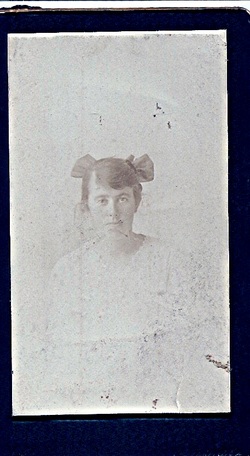
Bridget was the oldest of the three daughters of Martin and Mary Rabbitt, and she was born on 13 January 1907. She may have been named after her grandmother, Bridget Golding. Bridget was also known as Delia. (The sponsors at her baptism were Grange residents Michael Hurney and Mary Clarke.)
It is said that the Rabbitt home in Grange, was visited by the Royal Irish Constabulary (RIC) in search of some Bridget’s brothers who were “on the run”. Bridget was ‘roughed up’ when the RIC did not believe she was telling the truth about the whereabouts of her brothers. Although Bridget was already sick when she received the treatment at the hands of the RIC, the information is that this treatment contributed to her early death.
Bridget died on 13 October 1922, and the above picture is from a memorial card forwarded to New Zealand. She died at age 15 years and 11 months.
Bridget’s name is commemorated on the headstone of her grandparents, William and Bridget Rabbitt in the Lackagh Cemetery.
It is said that the Rabbitt home in Grange, was visited by the Royal Irish Constabulary (RIC) in search of some Bridget’s brothers who were “on the run”. Bridget was ‘roughed up’ when the RIC did not believe she was telling the truth about the whereabouts of her brothers. Although Bridget was already sick when she received the treatment at the hands of the RIC, the information is that this treatment contributed to her early death.
Bridget died on 13 October 1922, and the above picture is from a memorial card forwarded to New Zealand. She died at age 15 years and 11 months.
Bridget’s name is commemorated on the headstone of her grandparents, William and Bridget Rabbitt in the Lackagh Cemetery.
Mary 1908 - 1998

Mary is the second of the three daughters of Martin and Mary Rabbitt - presumably she was named after her mother. Mary was born on 21 September 1908; and the sponsors at her baptism were Mark McGrath, and “Mrs” Feeney. Both the McGrath and Feeney families were Grange residents.
Mary married a local farmer - Martin Mannion, who was born on 3 November 1904, and they lived in the Galway area.
Mary married a local farmer - Martin Mannion, who was born on 3 November 1904, and they lived in the Galway area.
Mary’s husband, Martin died on 7 December 1985, and in 1997 the authors met Mary when she was living in a nursing home in the Oranmore area of Galway.
Mary passed away on 22 May 1998, aged 89 years.
Nora 1910 - 1997

Nora is the youngest of the three daughters of Martin and Mary Rabbitt, nee Clarke. She was born at Grange, on 27 August 1910. (The sponsors at her baptism were Grange residents, Mary Feeney, and Martin Greaney.)
Nora married a local farmer – James (Jimmy) Murphy (1907 -1983); and lived in the Turloughmore district.
Nora married a local farmer – James (Jimmy) Murphy (1907 -1983); and lived in the Turloughmore district.
The photo (below left) believed to have been taken in the mid-late 1960’s shows Mary Murphy, ( married name Gannon) on her wedding day. The bridesmaid is her sister Catherine.
The younger son, Martin, (Mattie - below right) is quite a celebrity in Ireland. He was a very good hurler himself, and has had a few spells as manager of the Galway team. He has often appeared on Irish TV as a hurling pundit.
Hurling/Rabbitt’s/Jerseys
Extract from the Turloughmore GAA website
"In 1935 the Coolarne Team opted for a black and white jersey, because with Mattie Feeney, and Mattie Rabbitte both attending St Joseph’s College, Roscrea, they brought home a black and white jersey (school colours) each time they came home on holidays. The Coolarne youths for economic reasons said “why buy 15 when we only need 7” and so the club says thank you to the Grange lads for the 8 jerseys they brought from Roscrea”
The younger son, Martin, (Mattie - below right) is quite a celebrity in Ireland. He was a very good hurler himself, and has had a few spells as manager of the Galway team. He has often appeared on Irish TV as a hurling pundit.
Hurling/Rabbitt’s/Jerseys
Extract from the Turloughmore GAA website
"In 1935 the Coolarne Team opted for a black and white jersey, because with Mattie Feeney, and Mattie Rabbitte both attending St Joseph’s College, Roscrea, they brought home a black and white jersey (school colours) each time they came home on holidays. The Coolarne youths for economic reasons said “why buy 15 when we only need 7” and so the club says thank you to the Grange lads for the 8 jerseys they brought from Roscrea”
Nora, the mother of this family passed away on 16 August 1997.
Patrick (known as Paddy or Patch) 1912 - 1979
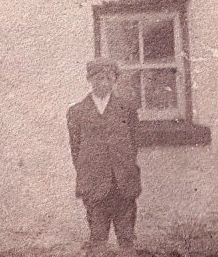
Patrick was the fourth son of Martin and Mary Rabbitt, and he was born at Grange on 3 March 1912. (The sponsors at his baptism were Grange residents, Patrick Greaney and Sara Hurney.) He attended the Roscrea College as did his brothers, Timothy and Martin. After 4 years at the college Patrick left and became a shop manager in Galway. Later he moved to London, and he is recorded as living there in 1959, not far from his younger brother, Martin.
Patrick corresponded with his cousins in New Zealand and apparently considered moving to New Zealand, but this never eventuated The following is a copy of a 1938 letter written to his cousin Patrick James Rabbitte ( 1896 – 1962) in New Zealand . Clearly the letter is part of continuing correspondence between the two.
Patrick corresponded with his cousins in New Zealand and apparently considered moving to New Zealand, but this never eventuated The following is a copy of a 1938 letter written to his cousin Patrick James Rabbitte ( 1896 – 1962) in New Zealand . Clearly the letter is part of continuing correspondence between the two.
Patrick was present at Grange, when his mother passed away in April 1948.
Patrick did not marry and died on 27 August 1979. He is buried at Lackagh Cemetery; old section.
Patrick did not marry and died on 27 August 1979. He is buried at Lackagh Cemetery; old section.
Martin (Jnr) 1914 - 1978
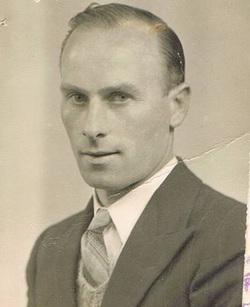
Martin, known as Mattie, was the youngest of the eight children of Martin and Mary Rabbitt (nee Clarke), and clearly he is named after his father. He was born at Grange on 18 April 1914, and the sponsors at his baptism were Patrick Cavanagh, and Nora Feeny of Grange.
His primary education was at the local Coolarne parish school, but the main influence on his life came with his secondary education. His uncle, Father Paul, was a senior member of the Cistercian Abbey at Mount St Joseph’s in Roscrea, Tipperary, and was a revered figure in the lives of all the family at that time. As a senior member of the Order (having been there since 1889,) Fr Paul was no doubt influential in facilitating Matties attendance at the school – following in the footsteps of his elder brothers Tim, (later Brother Enda,) and Paddy.
It must be understood that Roscrea was, and remains, one of the top few public schools in Ireland. It must have been a rare privilege for the sons of modest farming folk to be able to attend. The ethos of the school is very Irish and very Catholic and Mattie remained both to his dying day. He was a keen sportsman, an athlete and a hurler. He also picked up something that would have been completely alien to staunchly Republican Galway at that time - the garrison (i.e.English) game of rugby. As befits a top quality sprinter he was a flying wing three-quarter. Apparently he also had a good singing voice but didn’t pass that gene on to his kids!
It was while Mattie was still at school at Roscrea, that his brother Tim, who was studying for the priesthood, became ill, and spent the remainder of his life in the care of the Cistercians. It is known Mattie went to see Tim often and from reading his letters to his cousin Patrick in New Zealand it seems Tim was something of a hero to Mattie, and he felt his loss keenly. There is no doubt Tim’s breakdown gave Mattie his vocation for psychiatric nursing.
Mattie did his nursing training at the teaching hospital at Ballinasloe in East Galway. It was there that he met his wife to be Mary (Mamie) Daly, a farmer’s daughter from Gort, in South Galway
His primary education was at the local Coolarne parish school, but the main influence on his life came with his secondary education. His uncle, Father Paul, was a senior member of the Cistercian Abbey at Mount St Joseph’s in Roscrea, Tipperary, and was a revered figure in the lives of all the family at that time. As a senior member of the Order (having been there since 1889,) Fr Paul was no doubt influential in facilitating Matties attendance at the school – following in the footsteps of his elder brothers Tim, (later Brother Enda,) and Paddy.
It must be understood that Roscrea was, and remains, one of the top few public schools in Ireland. It must have been a rare privilege for the sons of modest farming folk to be able to attend. The ethos of the school is very Irish and very Catholic and Mattie remained both to his dying day. He was a keen sportsman, an athlete and a hurler. He also picked up something that would have been completely alien to staunchly Republican Galway at that time - the garrison (i.e.English) game of rugby. As befits a top quality sprinter he was a flying wing three-quarter. Apparently he also had a good singing voice but didn’t pass that gene on to his kids!
It was while Mattie was still at school at Roscrea, that his brother Tim, who was studying for the priesthood, became ill, and spent the remainder of his life in the care of the Cistercians. It is known Mattie went to see Tim often and from reading his letters to his cousin Patrick in New Zealand it seems Tim was something of a hero to Mattie, and he felt his loss keenly. There is no doubt Tim’s breakdown gave Mattie his vocation for psychiatric nursing.
Mattie did his nursing training at the teaching hospital at Ballinasloe in East Galway. It was there that he met his wife to be Mary (Mamie) Daly, a farmer’s daughter from Gort, in South Galway
In July 1947, Mattie and Mamie Rabbitte moved to live in London. The amazing thing was that they flew by Dakota DC3 into Northolt Airport and in those days there was little or no passenger air travel. The explanation may be that as Mattie and Mamie initially worked in private nursing, their services and skills were urgently needed by someone prepared to pay for the care they needed.
Mattie and Mamie had a family of three, all born in London, Christine, Michael (named after Mamie’s younger brother who died of tubeculosis aged only 21 years) and Una.
Mattie and Mamie had a family of three, all born in London, Christine, Michael (named after Mamie’s younger brother who died of tubeculosis aged only 21 years) and Una.
It was a great concern when not long after Michael was born, Mamie also contracted tuberculosis. She was treated in a sanatorium for two years and did not recover fully until the mid 1950’s.
By 1960 Mattie and Mamie had bought their first house, and to do so they had worked hard with long hours, secondary jobs, and night work. Mattie was now in the job which was to occupy him for the rest of his working life as a Charge Nurse in the addiction unit of St Bernard’s Psychiatric Hospital, in Ealing, West London. He was an enthusiastic disciple of the Consultant in charge, Max Glatt, whose methods he helped pioneer. Reading about Glatt’s character was almost as if you were reading about Mattie himself.
Once Mattie had achieved every emigrant’s objective of buying his own home and providing stability for his family, things relaxed a little though his work was still very important for him. He was a great believer in social justice and was a branch official for his unit in the Confederation of National Health Service Employees. He and Mamie mixed whenever possible with their friends in the Irish immigrant community in West London, which was the primary focus of their social life. Given his strong faith and personal morals it was not surprising that his views came into conflict with those of his free-spirited teenage children of the 1960’s…. you were always aware when he disapproved.
In early 1978 he was diagnosed with lung cancer and the diseased lung was removed. While he was recovering from the operation his heart failed and he died on 11 August 1978, aged only 64. He is buried in London.
Matties daughter in law describes him as; “a gentleman – the sort who would open a car door for you”.
He was softly spoken, precise in his use of language, and neat and tidy like his meticulous hand writing. He never left the house unshaven, and it was unusual to see him without a collar and tie. Cleaning and trimming his fingernails was the last thing he did every day of his life before going to work. Well, you wouldn’t want to be given your medication by a nurse with long, dirty fingernails would you?
The above was contributed by Matties son, Michael.
Like his elder brother, Patrick, Mattie corresponded with cousins in New Zealand. Included in the appendices are extracts from the correspondence from Martin Jnr; to his cousins in New Zealand.
Martin’s wife, Mamie, survived him by 32 years and she died in London in August 2010.
Two of Mattie and Mamies family, Michael and Christine, have visited New Zealand with their spouses (Judy and Mike) and met with many NZ family members.
By 1960 Mattie and Mamie had bought their first house, and to do so they had worked hard with long hours, secondary jobs, and night work. Mattie was now in the job which was to occupy him for the rest of his working life as a Charge Nurse in the addiction unit of St Bernard’s Psychiatric Hospital, in Ealing, West London. He was an enthusiastic disciple of the Consultant in charge, Max Glatt, whose methods he helped pioneer. Reading about Glatt’s character was almost as if you were reading about Mattie himself.
Once Mattie had achieved every emigrant’s objective of buying his own home and providing stability for his family, things relaxed a little though his work was still very important for him. He was a great believer in social justice and was a branch official for his unit in the Confederation of National Health Service Employees. He and Mamie mixed whenever possible with their friends in the Irish immigrant community in West London, which was the primary focus of their social life. Given his strong faith and personal morals it was not surprising that his views came into conflict with those of his free-spirited teenage children of the 1960’s…. you were always aware when he disapproved.
In early 1978 he was diagnosed with lung cancer and the diseased lung was removed. While he was recovering from the operation his heart failed and he died on 11 August 1978, aged only 64. He is buried in London.
Matties daughter in law describes him as; “a gentleman – the sort who would open a car door for you”.
He was softly spoken, precise in his use of language, and neat and tidy like his meticulous hand writing. He never left the house unshaven, and it was unusual to see him without a collar and tie. Cleaning and trimming his fingernails was the last thing he did every day of his life before going to work. Well, you wouldn’t want to be given your medication by a nurse with long, dirty fingernails would you?
The above was contributed by Matties son, Michael.
Like his elder brother, Patrick, Mattie corresponded with cousins in New Zealand. Included in the appendices are extracts from the correspondence from Martin Jnr; to his cousins in New Zealand.
Martin’s wife, Mamie, survived him by 32 years and she died in London in August 2010.
Two of Mattie and Mamies family, Michael and Christine, have visited New Zealand with their spouses (Judy and Mike) and met with many NZ family members.
Bridget Rabbitt (1868 - 1949)
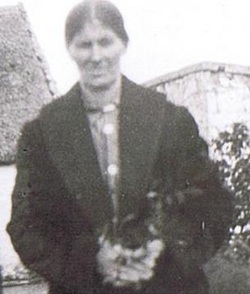
Bridget was the second of the two daughters of William and Bridget Rabbitt, of Grange, Turloughmore, and she was born on the 2 July 1868. Sponsors at her christening were Michael Fahey and Sabina Fahey, also Grange residents.
She was the youngest of their seven children, and presumably she was named after her mother. Three of Bridget’s brothers, (John, Patrick and William), settled in New Zealand. One brother, (Timothy), became Father Paul at the St Joseph’s Abbey monastery in Roscrea, and another brother ( Martin), remained on the land in the Grange district.
There are indications in letters to her brothers that Bridget planned to come to New Zealand to settle, however this did not occur. On 7 February 1891, Bridget married Michael Holland, of Lisheenavalla, in County Galway. Bridget was aged 22 years, and Michael 26 years at the time of their marriage. Witnesses at their wedding were Thomas Costelloe, and Honor Fahey, both of whom were residents of the Grange district. (See local area maps in the appendices, to confirm the nearby locations of the Costelloe and Fahey family homes.) The witness (Honor Fahey) was later to marry Bridget’s younger brother William Rabbitt, and eventually settle in New Zealand.
From correspondence dated in 1893 it is known that Bridget was in America, living in Helena, in the state of Montana. It appears the intention was that her husband would join her however this did not occur, and by 1894 Bridget had returned to Ireland. On her return, Bridget had some misfortune with land disputes and was evicted from land at “Doughiska, above Briarhill”. Later, after their children began arriving from 1895/96, Bridget and Michael bought a holding of land, (26 acres,) on Castlelambert, near Turloughmore, and their descendants are still living in this area.
Bridget and Michael Holland had a family of 4 sons, and 4 daughters, who were born in Ireland over the 13 year period from 1895/96 until 1909. Details of their family are;
Thomas born 1896 approximately
William born 1897 “
Brigid born 1900 “
Mary born 1902 “
Patrick born 1903 “
Kattie born 1904 “
John born 1906 “
Sarah born 1909 “
(All the above years of birth are shown as approximate only, as the actual birth registrations in Ireland have not been sighted.)
The Castlelambert land purchased by the Hollands, was of 26 acres, and with the help of Bridget’s youngest brother, William Rabbitt, (born in 1873), a new house was built on property. Bridget was an enthusiastic gardener. Around her house she maintained lilac trees, and climbing roses; while small flowering plants like pansies, daffodils and snowdrops lined the paths. There were privet and snowberry hedges on all sides of her garden.
Inside her home Bridget favoured strong reds and yellows on the walls, and she had a large collection of ornamental teapots, jugs, cake-stands and vases - some of these items survive today in the possession of her grandson.
The following photograph, taken in the 1930’s, shows Bridget with her husband, Michael Holland, and their typically Irish home is shown in the background. (Bridget and Michael would have been in the 40-50 age approximately when this photo was taken).
She was the youngest of their seven children, and presumably she was named after her mother. Three of Bridget’s brothers, (John, Patrick and William), settled in New Zealand. One brother, (Timothy), became Father Paul at the St Joseph’s Abbey monastery in Roscrea, and another brother ( Martin), remained on the land in the Grange district.
There are indications in letters to her brothers that Bridget planned to come to New Zealand to settle, however this did not occur. On 7 February 1891, Bridget married Michael Holland, of Lisheenavalla, in County Galway. Bridget was aged 22 years, and Michael 26 years at the time of their marriage. Witnesses at their wedding were Thomas Costelloe, and Honor Fahey, both of whom were residents of the Grange district. (See local area maps in the appendices, to confirm the nearby locations of the Costelloe and Fahey family homes.) The witness (Honor Fahey) was later to marry Bridget’s younger brother William Rabbitt, and eventually settle in New Zealand.
From correspondence dated in 1893 it is known that Bridget was in America, living in Helena, in the state of Montana. It appears the intention was that her husband would join her however this did not occur, and by 1894 Bridget had returned to Ireland. On her return, Bridget had some misfortune with land disputes and was evicted from land at “Doughiska, above Briarhill”. Later, after their children began arriving from 1895/96, Bridget and Michael bought a holding of land, (26 acres,) on Castlelambert, near Turloughmore, and their descendants are still living in this area.
Bridget and Michael Holland had a family of 4 sons, and 4 daughters, who were born in Ireland over the 13 year period from 1895/96 until 1909. Details of their family are;
Thomas born 1896 approximately
William born 1897 “
Brigid born 1900 “
Mary born 1902 “
Patrick born 1903 “
Kattie born 1904 “
John born 1906 “
Sarah born 1909 “
(All the above years of birth are shown as approximate only, as the actual birth registrations in Ireland have not been sighted.)
The Castlelambert land purchased by the Hollands, was of 26 acres, and with the help of Bridget’s youngest brother, William Rabbitt, (born in 1873), a new house was built on property. Bridget was an enthusiastic gardener. Around her house she maintained lilac trees, and climbing roses; while small flowering plants like pansies, daffodils and snowdrops lined the paths. There were privet and snowberry hedges on all sides of her garden.
Inside her home Bridget favoured strong reds and yellows on the walls, and she had a large collection of ornamental teapots, jugs, cake-stands and vases - some of these items survive today in the possession of her grandson.
The following photograph, taken in the 1930’s, shows Bridget with her husband, Michael Holland, and their typically Irish home is shown in the background. (Bridget and Michael would have been in the 40-50 age approximately when this photo was taken).
Family recollections of Bridget Holland (nee Rabbitt), are those of a woman of strong character. She has been described as “larger than life, stubborn and fiery, given to large gestures and playing everything to the hilt”. Yet she has also been described as a very proud woman, with great dignity and self respect. She was a generous spirit, and very strong on family values. When grand children, in-laws, emigrant relatives, and other visitors arrived at her house, they were treated with lavish hospitality, and encouraged to stay as long as they liked. Other occasions like Christmas, Station Masses, ordinations, and weddings were celebrated on a grand scale, and Bridget’s home was seen as the family centre, and an open house.
The Holland family, like some of the family of Bridget’s brother, Martin (1865 -1932), were actively involved in the Irish troubles of the 1916-1925 era Bridget and Michael Holland were committed to the republican cause, and they maintained a “safe house” where people on the run often hid for months at a time. About 1920 their house was regularly searched, by the authorities, sometimes three times a week, and there was always the danger that it would be burnt down as a reprisal. There was some looting, and the story is told of when Bridget caught a British officer taking a watch from a dresser; she grabbed his hand and bit it until he let go!!
Members of Bridget’s family were also “republicans” and they were involved in many amazing incidents of challenge to the authorities. (Details of these incidents are included in the individual family details which follow.)
In March 1940, Bridget was present with members of her family, at Roscrea, for the funeral of her brother; - Father Paul.
In 1941 Bridget built a larger two-storeyed slated home, although the original home was still fairly intact at that time. The new building was quite an imposing one, and this was achieved at a time when most people had small thatched cottages. All this cost money and although the 1930’s and 1940’s were not prosperous times in Ireland, Bridget was not one to be daunted, and achieved her aims regardless.
The Holland family, like some of the family of Bridget’s brother, Martin (1865 -1932), were actively involved in the Irish troubles of the 1916-1925 era Bridget and Michael Holland were committed to the republican cause, and they maintained a “safe house” where people on the run often hid for months at a time. About 1920 their house was regularly searched, by the authorities, sometimes three times a week, and there was always the danger that it would be burnt down as a reprisal. There was some looting, and the story is told of when Bridget caught a British officer taking a watch from a dresser; she grabbed his hand and bit it until he let go!!
Members of Bridget’s family were also “republicans” and they were involved in many amazing incidents of challenge to the authorities. (Details of these incidents are included in the individual family details which follow.)
In March 1940, Bridget was present with members of her family, at Roscrea, for the funeral of her brother; - Father Paul.
In 1941 Bridget built a larger two-storeyed slated home, although the original home was still fairly intact at that time. The new building was quite an imposing one, and this was achieved at a time when most people had small thatched cottages. All this cost money and although the 1930’s and 1940’s were not prosperous times in Ireland, Bridget was not one to be daunted, and achieved her aims regardless.
A grand daughter of Bridget when recalling her grandmother writes; “When I was very young, I remember her sitting on the kitchen table transcribing the “Irish Press” into Irish for the evening visitors - neighbours, who were more comfortable in the Irish language. She read by camplight, and without spectacles!!”
In 1941, Bridget’s husband, Michael Holland, passed away at the age of 76 years.
Bridget survived her husband by eight years, and passed away at Lisheenkyle, on the 24 April, 1949. She was the last to die of the 5 sons and 2 daughters of William and Bridget Rabbitt of Grange. She was aged 79 years and her cause of death is recorded as “senility”. Her daughter Bridget Courtney, then living at Castle Lambert, was present at her death
The following is a copy of Bridget’s death certificate;
In 1941, Bridget’s husband, Michael Holland, passed away at the age of 76 years.
Bridget survived her husband by eight years, and passed away at Lisheenkyle, on the 24 April, 1949. She was the last to die of the 5 sons and 2 daughters of William and Bridget Rabbitt of Grange. She was aged 79 years and her cause of death is recorded as “senility”. Her daughter Bridget Courtney, then living at Castle Lambert, was present at her death
The following is a copy of Bridget’s death certificate;
Much of the information about Bridget, and of her family which follows, was contributed by Bridget’s grandson, Padraig Holland. Padraig concludes his words about his grandmother with the following remarks;
“I’m told she was very much a Rabbitt – which according to my father means being proud, generous, capable of towering rages, stubborn ,determined to enjoy life, and strong on family values”.
“I’m told she was very much a Rabbitt – which according to my father means being proud, generous, capable of towering rages, stubborn ,determined to enjoy life, and strong on family values”.
Details of the family of Bridget and Michael Holland
Thomas (Tommy) 1896 - 1969

Lackagh records show Thomas was born on 26 April 1896. He was the first of the eight family of Bridget (nee Rabbitt), and Michael Holland. The sponsors at his baptism were Martin Rabbitt and Mary Holland. (Martin was Tommy’s uncle; - his mothers older brother.)
Tommy Holland would have been aged in his early twenties when the Irish patriotic activities began. He is known to have been very actively involved in the troubled times, and actually took part in gun battles. Tommy Holland was involved in one particular incident, when along with a friend, Bill Feeney, he was detailed to burn down the tennis club at Athenry. This activity was planned to divert attention from other patriotic actions which were taking place elsewhere. Tommy and Bill were using petrol, which they had not used before, and they were unaware how volatile it was. After sprinkling petrol around the building, they lit a match at the door, and the building exploded. Bill Feeney was trapped and burnt to death. Tommy was thrown clear. Worse was to come for Tommy. Bill’s body could not be buried in consecrated ground until it had been formally identified, and the only person who could possibly do so was Tommy. For Tommy to have done so, would probably have cost him his life, as he would have had to reveal his part in the incident. Tommy had to live with his secret; - he was traumatised by the incident, and claimed to be haunted by Bill Feeney’s ghost.
Tommy later went to America (New York), where he married May Kelly. They had a family of four; Paul, John, Patricia, and Mary.
Thomas Holland died in America in 1969 - aged approx 74 years.
Tommy Holland would have been aged in his early twenties when the Irish patriotic activities began. He is known to have been very actively involved in the troubled times, and actually took part in gun battles. Tommy Holland was involved in one particular incident, when along with a friend, Bill Feeney, he was detailed to burn down the tennis club at Athenry. This activity was planned to divert attention from other patriotic actions which were taking place elsewhere. Tommy and Bill were using petrol, which they had not used before, and they were unaware how volatile it was. After sprinkling petrol around the building, they lit a match at the door, and the building exploded. Bill Feeney was trapped and burnt to death. Tommy was thrown clear. Worse was to come for Tommy. Bill’s body could not be buried in consecrated ground until it had been formally identified, and the only person who could possibly do so was Tommy. For Tommy to have done so, would probably have cost him his life, as he would have had to reveal his part in the incident. Tommy had to live with his secret; - he was traumatised by the incident, and claimed to be haunted by Bill Feeney’s ghost.
Tommy later went to America (New York), where he married May Kelly. They had a family of four; Paul, John, Patricia, and Mary.
Thomas Holland died in America in 1969 - aged approx 74 years.
William (Willie) 1897 - 1988/89

William and his wife Alice (nee Hughes)
William Holland was the first or second son of Bridget and Michael Holland..
Lackagh records indicate he was born on 1 September 1897, and there is a baptism record for William Holland in 1897; - the sponsors were William Rabbitt (Bridget’s brother) and Catherine Holland.
Willie was also involved in the patriotic activities. Later he went to America, and there he married Alice Hughes.
There were seven children in their family; - Mary Michel, Rosaleen, Patricia, Frances, Sheila, Dennis, and William.
In 1979 Willie visited family in Galway and told of being 84 years of age - this puts his year of birth about 1895; slightly different to that on the baptism record. This difference in dates is minor, however it is significant, because it makes it unclear as to which of Thomas and William Holland is the elder son. The weight of the evidence is that Thomas was the eldest.
William died in America in 1988/89.
Lackagh records indicate he was born on 1 September 1897, and there is a baptism record for William Holland in 1897; - the sponsors were William Rabbitt (Bridget’s brother) and Catherine Holland.
Willie was also involved in the patriotic activities. Later he went to America, and there he married Alice Hughes.
There were seven children in their family; - Mary Michel, Rosaleen, Patricia, Frances, Sheila, Dennis, and William.
In 1979 Willie visited family in Galway and told of being 84 years of age - this puts his year of birth about 1895; slightly different to that on the baptism record. This difference in dates is minor, however it is significant, because it makes it unclear as to which of Thomas and William Holland is the elder son. The weight of the evidence is that Thomas was the eldest.
William died in America in 1988/89.
Brigid 1900 - 1954

Brigid was the third child of Bridget and Michael Holland, and she was born in the year 1900. She was the first of their four daughters, and is probably named after her mother.
Brigid married John Christopher (Christy) Courtney, and they had a family of seven. Brigid’s husband was another person who was actively involved in the patriotic activities of 1916-1925. It was been noted earlier that the Holland family home was a “safe house” for people who were on the run from the British authorities, and one such person who stayed at the house for long periods was Christy Courtney. Christy Courtney was active in the Irish Republican Army, as it later became known, and he took part in gun battles. It is probable he would have been executed had he been captured, and he had some remarkable escapes from the British authorities. About 1922 there was an incident when most of the Holland family, (including three sisters), and Christy Courtney, were in the Hangar Ballroom, outside of Galway. The ballroom was surrounded by Free State soldiers looking for Christy Courtney. The women were allowed to leave, and Courtney escaped with them, wearing some of the women’s clothing. Women then wore huge shawls pulled up around their heads; and it is believed Courtney escaped wearing the shawl of his wife’s sister; - Kathy Holland.
The British officer found out too late what was going on, and got into a shouting match with the Holland sisters. Eventually he lost his temper, and shot one of the sisters in the chest. Luckily the bullet was too high to kill, but relatives were still able to see the scars when they met her many years later. A few months later Courtney had another lucky escape when Free State soldiers raided the old family home, in order to kill him. Martin Kelly, a Castlelambert man who was a Free State soldier, pretended to scout out the house, and warned Courtney to get away. This act was to be the beginning of a life-long friendship between the Kelly’s, the Holland’s, and the Courtney’s.
Brigid (nee Holland), and John Christopher Courtney’s seven family were; - Margaret (Peggy), Emmett, Michael, Brendan, Nuala, Pearce, and Francis.
Brigid Courtney died of coronary thrombosis, at age 54.
Brigid married John Christopher (Christy) Courtney, and they had a family of seven. Brigid’s husband was another person who was actively involved in the patriotic activities of 1916-1925. It was been noted earlier that the Holland family home was a “safe house” for people who were on the run from the British authorities, and one such person who stayed at the house for long periods was Christy Courtney. Christy Courtney was active in the Irish Republican Army, as it later became known, and he took part in gun battles. It is probable he would have been executed had he been captured, and he had some remarkable escapes from the British authorities. About 1922 there was an incident when most of the Holland family, (including three sisters), and Christy Courtney, were in the Hangar Ballroom, outside of Galway. The ballroom was surrounded by Free State soldiers looking for Christy Courtney. The women were allowed to leave, and Courtney escaped with them, wearing some of the women’s clothing. Women then wore huge shawls pulled up around their heads; and it is believed Courtney escaped wearing the shawl of his wife’s sister; - Kathy Holland.
The British officer found out too late what was going on, and got into a shouting match with the Holland sisters. Eventually he lost his temper, and shot one of the sisters in the chest. Luckily the bullet was too high to kill, but relatives were still able to see the scars when they met her many years later. A few months later Courtney had another lucky escape when Free State soldiers raided the old family home, in order to kill him. Martin Kelly, a Castlelambert man who was a Free State soldier, pretended to scout out the house, and warned Courtney to get away. This act was to be the beginning of a life-long friendship between the Kelly’s, the Holland’s, and the Courtney’s.
Brigid (nee Holland), and John Christopher Courtney’s seven family were; - Margaret (Peggy), Emmett, Michael, Brendan, Nuala, Pearce, and Francis.
Brigid Courtney died of coronary thrombosis, at age 54.
Mary 1902 - 1976

Mary Holland was the second daughter of Bridget and Michael Holland, and she was born in 1902.
Mary Holland was also involved in the incident at the Hangar Ballroom, near Galway, when the authorities tried to capture Christy Courtney. Mary and her sisters frustrated the British officer to the point where he lost his temper and Mary was the sister who received the gun shot wound in the chest. Fortunately the bullet was too high to kill, although 50 years later Mary was still able to show her relatives the scars of her wounds; a red mark at the front, and a purplish red patch at the back.
Mary had a strong personality, and could be as stubborn and strong willed as her mother. One of the great family tales is about a Protestant man (Jack Morrow) from Monivea, (Galway); who was in love with Mary. According to Mary she wanted to marry the him, but her mother overruled it. Catholics at that stage were very doctrinaire and she could not accept marriage to a Protestant. Jack Morrow offered to convert to the Catholic religion, but Mary refused to hear of it. By this time tempers were up and reason played no part in what happened next.
Mary discreetly made arrangements to go to America. One night she stole out the back window with her bags, and leaving Galway for ever, took ship to America. Mary’s mother, Bridget was extremely upset by what had happened and had what amounted to a nervous breakdown, as she coped with the sudden departure of her daughter.
Like her mother, Mary was a larger than life figure. She was also ambitious and eventually she owned her own hotel in New York. Similarly to what her mother had provided in Galway, Mary provided generous hospitality, and visitors were encouraged to stay as long as they liked. Mary’s hotel in New York became a centre for the many family members who eventually settled in the New York area.
Mary Holland never married, and she passed away in New York in 1976; aged 74 years.
Mary Holland was also involved in the incident at the Hangar Ballroom, near Galway, when the authorities tried to capture Christy Courtney. Mary and her sisters frustrated the British officer to the point where he lost his temper and Mary was the sister who received the gun shot wound in the chest. Fortunately the bullet was too high to kill, although 50 years later Mary was still able to show her relatives the scars of her wounds; a red mark at the front, and a purplish red patch at the back.
Mary had a strong personality, and could be as stubborn and strong willed as her mother. One of the great family tales is about a Protestant man (Jack Morrow) from Monivea, (Galway); who was in love with Mary. According to Mary she wanted to marry the him, but her mother overruled it. Catholics at that stage were very doctrinaire and she could not accept marriage to a Protestant. Jack Morrow offered to convert to the Catholic religion, but Mary refused to hear of it. By this time tempers were up and reason played no part in what happened next.
Mary discreetly made arrangements to go to America. One night she stole out the back window with her bags, and leaving Galway for ever, took ship to America. Mary’s mother, Bridget was extremely upset by what had happened and had what amounted to a nervous breakdown, as she coped with the sudden departure of her daughter.
Like her mother, Mary was a larger than life figure. She was also ambitious and eventually she owned her own hotel in New York. Similarly to what her mother had provided in Galway, Mary provided generous hospitality, and visitors were encouraged to stay as long as they liked. Mary’s hotel in New York became a centre for the many family members who eventually settled in the New York area.
Mary Holland never married, and she passed away in New York in 1976; aged 74 years.
Patrick (Packie) 1903 - 1968

Patrick was the fifth child of Bridget and Michael Holland, and he was born about 1903. He was their third son.
In 1922, Patrick was wounded in the Civil War which followed the War of Independence. The period of the Civil War was actually a period of greater danger, for those involved, because all sorts of scores were settled; - Patrick was slightly wounded by a shot in the back.
Like his older brothers, Thomas and William, and sister Mary, Patrick eventually went to America, and married. He is the father of two daughters; Rosemary and Susan. It is known that he worked on the railroad, and died in 1968, one year after his retirement.
In 1922, Patrick was wounded in the Civil War which followed the War of Independence. The period of the Civil War was actually a period of greater danger, for those involved, because all sorts of scores were settled; - Patrick was slightly wounded by a shot in the back.
Like his older brothers, Thomas and William, and sister Mary, Patrick eventually went to America, and married. He is the father of two daughters; Rosemary and Susan. It is known that he worked on the railroad, and died in 1968, one year after his retirement.
Kathy (Kattie) 1904 - 1986

Kathy Holland, who was known as Kattie, was born in 1904. She was the third daughter of Bridget and Michael Holland, and she married a neighbour, John Martyn, There was one daughter; - Teresa, who died in 1998. Kattie and her daughter lived in Ballinasloe where Kattie worked in the same mental hospital as her cousin, Martin Rabbitt. Kathy Martin died in Galway in 1986.
John (Johnny) 1906 - 1985

John Holland was born on 6 December 1906 - he was the sixth child and fourth son of Bridget and Michael Holland.
Although only a teenager, Johnny Holland was also involved in the Irish troubles. At times he lay in bed pretending to be asleep while the British soldiers, known as the Black and Tans, searched the house. (Unknown to the soldiers, Johnny was holding the gun of his brother in law, Christy Courtney, under his night shirt!)
On occasions, Johnny was involved in the carriage of explosives, usually in the loads of hay, which the Holland family sold in Galway City. He was also the link with the Dublin criminals who cashed postal orders and bonds which had been taken in raids on banks or trains. From time to time, Johnny brought the proceeds of these raids into a hotel and exchanged them for cash with the Dublin contact. He was not suspected as he was only 14 or 15 years of age at the time!!
John Holland married Mary Regan; and they had two sons; - Padraig, and Paul. After his mother’s death in 1949, John Holland continued to work the land which his parents had worked before him, and he died in Galway in1985.
Although only a teenager, Johnny Holland was also involved in the Irish troubles. At times he lay in bed pretending to be asleep while the British soldiers, known as the Black and Tans, searched the house. (Unknown to the soldiers, Johnny was holding the gun of his brother in law, Christy Courtney, under his night shirt!)
On occasions, Johnny was involved in the carriage of explosives, usually in the loads of hay, which the Holland family sold in Galway City. He was also the link with the Dublin criminals who cashed postal orders and bonds which had been taken in raids on banks or trains. From time to time, Johnny brought the proceeds of these raids into a hotel and exchanged them for cash with the Dublin contact. He was not suspected as he was only 14 or 15 years of age at the time!!
John Holland married Mary Regan; and they had two sons; - Padraig, and Paul. After his mother’s death in 1949, John Holland continued to work the land which his parents had worked before him, and he died in Galway in1985.
Sarah 1909 - 1993

Sarah Holland - taken in Ireland
Sarah, the final of the eight children of Bridget and Michael Holland, was born in 1909.
Sarah married a farmer from the Castle Lambert area, - Tim Murray.
There was one child in their family; - a daughter Maura.
Sarah was like her mother, (Bridget), in that she was very hospitable, providing huge meals and offers for visitors to stay as long as they liked. Sarah’s home in Derrydonnell was seen as a family centre, just as her mother’s had been. She and her husband owned the local store at Derrydonnell.
Sarah was the longest surviving member of the family, and she passed away in 1993, when she was 84 years of age.
Sarah married a farmer from the Castle Lambert area, - Tim Murray.
There was one child in their family; - a daughter Maura.
Sarah was like her mother, (Bridget), in that she was very hospitable, providing huge meals and offers for visitors to stay as long as they liked. Sarah’s home in Derrydonnell was seen as a family centre, just as her mother’s had been. She and her husband owned the local store at Derrydonnell.
Sarah was the longest surviving member of the family, and she passed away in 1993, when she was 84 years of age.
